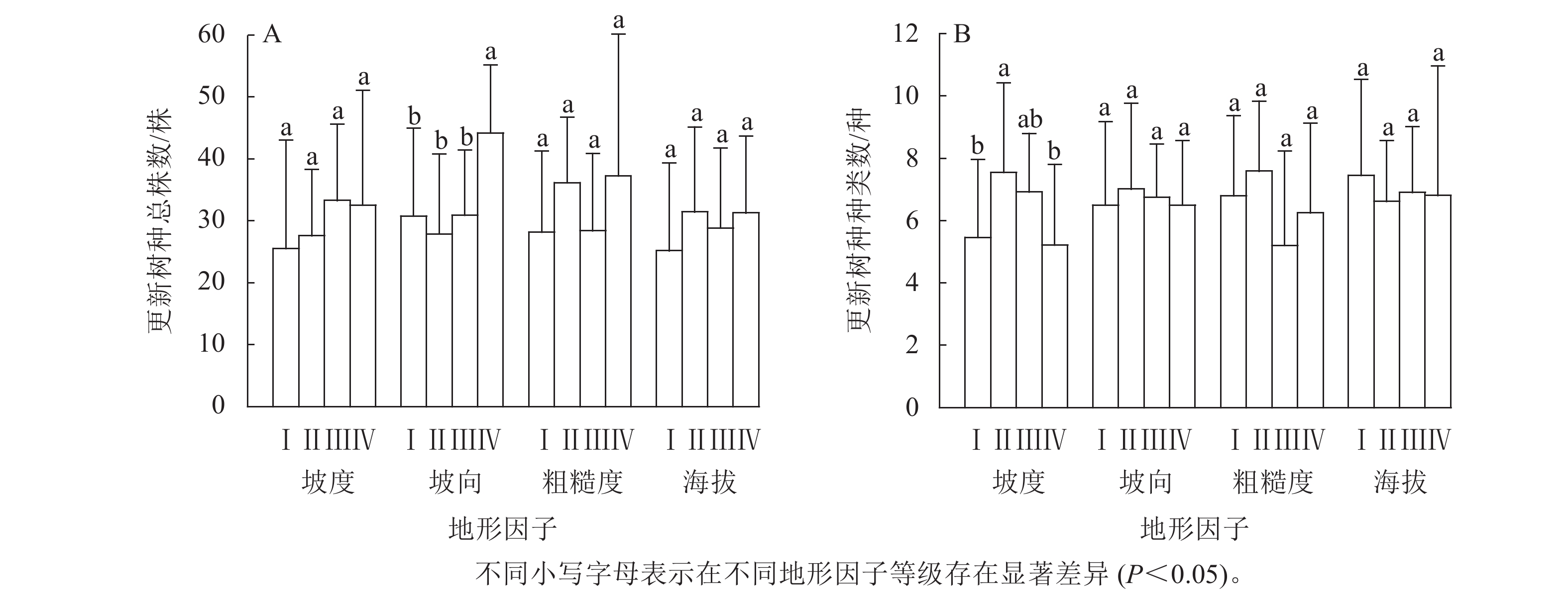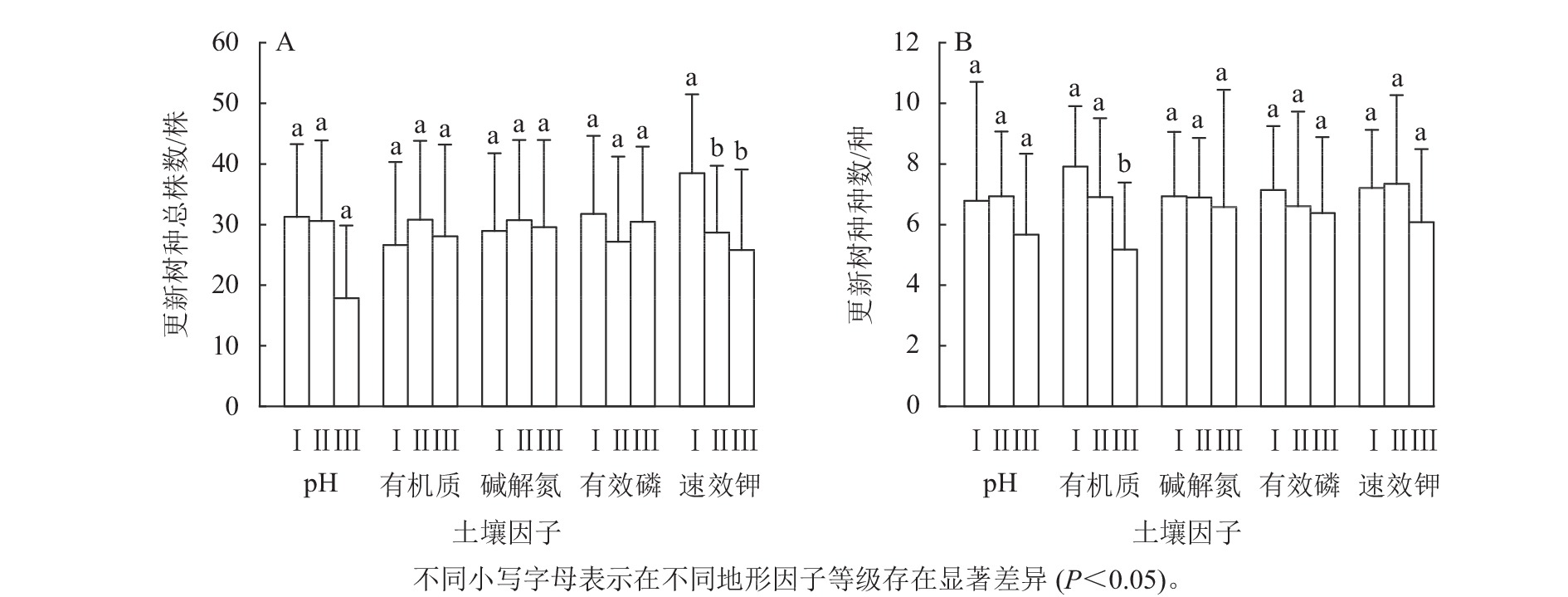-
立地因子是影响树木生长发育的环境因子,包括气候、地形和土壤等[1−2]。在一定气候区内,森林的差异主要受地形、土壤等因子的影响[3]。林木更新是指林木在时间、空间尺度上的延续、发展和演替[4],对恢复森林生态系统、维持生物多样性具有重要意义[5],同时也是推动森林演替发展的重要驱动因子[6]。林木天然更新是一个受到诸多因素影响的复杂过程,除了受到林木自身的遗传学和生态学特征[7]影响外,林分结构[8]、地形因子[9]、土壤因子[10]和环境干扰[11]等对林木更新也产生重要影响。地形和土壤作为影响林木生长的两大重要立地因子,通过影响林分内的水热状况和土壤养分等对林木更新产生显著影响,在林木更新过程中的作用不容忽视[12]。黄朗等[13]在研究湖南栎类天然次生林时,发现海拔与湖南亮叶水青冈Fagus lucida、多脉青冈Quercus multinervis混交林幼树密度具有显著的正相关性。DYDERSKI等[14]研究认为:较低pH的土壤有利于挪威云杉Picea asperata幼苗密度的增加。
亚热带针阔混交林是由针叶林向常绿阔叶林过渡的一种森林植被类型,是亚热带常绿阔叶林次生演替过程中一个重要环节[15]。亚热带针阔混交林在浙闽丘陵一带广泛分布,无论是在调节气候、涵养水源等生态效益方面,还是在林产品供给、生态旅游等社会经济效益方面都有着巨大的价值[16],但目前对亚热带针阔混交林林木天然更新影响因子的研究较少。杨娟等[17]在对卧龙自然保护区针阔混交林林隙更新规律的研究中发现:土壤因子是影响优势树种天然更新和更新物种多样性的潜在因素,但并未分析土壤中各种养分及地形对林木更新的作用。本研究以浙江天目山国家级自然保护区的针阔混交林为研究对象,采用Spearman 相关性分析、单因素方差分析和线性回归模型,分析亚热带针阔混交林林木更新与地形、土壤因子之间的关系,为亚热带针阔混交林的经营管理提供理论依据。
-
浙江天目山国家级自然保护区地处浙江省杭州市临安区,30°18′30″~30°24′55″N, 119°23′47″~119°28′27″E。该区气候类型为典型亚热带季风气候,年平均气温为8.8~14.8 ℃,最冷月平均气温为2.6~3.4 ℃,最热月平均气温为19.9~28.1 ℃,无霜期为209.0~235.0 d,气候温和。受海洋暖湿气流影响,降水充足,年降水量为1 390.0~1 870.0 mm,形成浙江西北部的多雨中心。山体土壤随海拔升高由亚热带红壤向温带黄壤过渡。森林类型丰富,是中国亚热带高等植物较丰富的地区[18]。
-
2006年,在研究区选择具有代表性的地段,设置100 m×100 m的针阔混交林固定样地,用相邻格子法将样地分为100个10 m×10 m的网格单元。在每一网格单元内,对样地内胸径<5 cm的林木进行每木检尺,记录树种并测定胸径、树高、冠幅等,并采用激光对中全站仪(徕卡 TCR702Xrange)测量林木空间坐标(x, y, z)。自2006年设置样地开始,每隔5 a对该样地进行1次复查。本研究采用2021年复查数据进行分析。
-
采用网格单元中更新树种总株数和更新树种种数表示样地林木更新的物种多样性水平。
-
采用重要值分析法筛选样地优势树种[19]。
-
根据激光对中全站仪所测量得到的网格单元顶点坐标(x, y, z),计算网格单元的坡度、坡向、粗糙度[20−21]。根据样地内地形因子的数据,将各地形因子按表1标准进行分级[22]。
分级 坡度/(°) 坡向/(°) 海拔/m 粗糙度/m Ⅰ ≥50 >202.5(西南坡) ≥680(高海拔) ≥6 Ⅱ 40~50 157.5~202.5(南坡) 650~680(中高海拔) 4~6 Ⅲ 30~40 112.5~157.5(东南坡) 620~650(中海拔) 2~4 Ⅳ <30 <112.5(东坡) <620(低海拔) <2 说明:表中数值范围采用上限排除法。 Table 1. Classification criteria for each terrain factor
-
土壤因子包括土壤pH以及有机质、碱解氮、速效钾和有效磷质量分数5项指标。土壤pH采用复合电极法测定,有机质质量分数采用重铬酸钾容量法测定,碱解氮质量分数采用碱解扩散法测定,速效钾质量分数采用乙酸铵提取火焰光度计法测定,有效磷质量分数采用硫酸-高氯酸消煮法测定[23]。根据样地内各土壤因子的数据分布情况,将各土壤因子按表2标准进行分级。
分级 pH 有机质质量分数/(g·kg−1) 碱解氮质量分数/(mg·kg−1) 有效磷质量分数/(mg·kg−1) 速效钾质量分数/(mg·kg−1) Ⅰ ≥5.5(弱酸) ≥200 ≥300 ≥20 ≥200 Ⅱ 5.0~5.5(酸) 100~200 200~300 10~20 150~200 Ⅲ <5.0(强酸) 50~100 100~200 5~10 <150 Ⅳ − <50 <100 <5 − 说明:表中数值范围采用上限排除法。−表示无此项。 Table 2. Classification criteria for each soil factor
-
分别以2个林木更新指标为因变量,以地形因子和土壤因子为自变量,构建全地形因子模型、全土壤因子模型以及全地形因子和全土壤因子的综合模型。具体构建的线性回归方程为:
其中:y表示更新树种总株数或更新树种种数;k1和k2取值为0或1;ai为回归系数(i=0,1,…,9);xi为变量(i=1,2,3,4,5时,变量为土壤因子,依次为土壤pH以及有机质、碱解氮、有效磷、速效钾质量分数;i=6,7,8,9时,变量为地形因子,依次为坡度、坡向、粗糙度、海拔);ɛ为残差。
-
采用Excel 2023对调查数据进行预处理,计算林分更新指标;利用Origin 2018绘制单元网格更新树种三维堆积图;利用SPSS 26对立地变量和林木更新因子进行正态性检验,其中更新树种总株数、更新树种种数、土壤pH、坡度、坡向、海拔以及土壤速效钾、有效磷质量分数满足正态分布,有机质、碱解氮质量分数以及地表粗糙度不满足正态分布;利用Spearman相关性分析和单因素方差分析方法分析不同地形、土壤因子等级下,样地林木更新指标的差异性;利用SPSS 26对林木更新因子构建线性回归模型。
-
通过样地更新调查,统计出更新林木共计2 991株,79个树种。筛选重要值大于2的树种为优势树种,其中阔叶树种9种,重要值占78.02%;针叶树种1种,重要值占2.78% (表3)。
树种 株数/株 株数占比/% 重要值 树种 株数/株 株数占比/% 重要值 连蕊茶Camellia fraterna 1462 48.87 35.55 榧树Torreya grandis 41 1.37 2.78 青冈Cyclobalanopsis glauca 495 16.54 15.98 山胡椒Lindera glauca 63 2.10 2.77 短尾柯Lithocarpus brevicaudatus 209 6.98 7.34 柃木Eurya japonica 46 1.53 2.28 小叶青冈Cyclobalanopsis myrsinifolia 121 4.04 5.92 豹皮樟Litsea coreana 34 1.13 2.19 润楠Machilus pingii 68 2.27 3.11 优势树种总计 2 603 87.03 80.82 马银花Rhododendron ovatum 64 2.13 2.86 Table 3. Main dominant species in the sample plot
对每一网格单元的林木更新情况进行统计,得到了单元网格树种更新的三维堆积图(图1)。可见,不同网格单元林木更新情况差异较大,其中连蕊茶、青冈等优势树种广泛分布在样地中。
-
因部分变量并不符合正态分布,故对各指标进行Spearman相关分析(表4)。结果表明:更新树种总株数与土壤速效钾呈现极显著负相关(P<0.01),与海拔呈现极显著正相关(P<0.01);更新树种种数与土壤速效钾呈现极显著负相关(P<0.01),与土壤有机质呈现显著负相关(P<0.05)。说明土壤因子和地形因子影响林木更新。
指标 S Nu pH SOM N P K Sl As SR A S 1 Nu 0.407** 1 pH 0.027 0.087 1 SOM 0.003 −0.235* −0.445** 1 N 0.001 −0.180 −0.462** 0.774** 1 P −0.168 −0.115 −0.650** 0.365** 0.412** 1 K −0.336** −0.258** −0.300** 0.531** 0.579** 0.462** 1 Sl 0.180 0.040 −0.156 0.090 −0.041 −0.004 -0.112 1 As 0.165 0.046 0.096 −0.123 −0.194 −0.146 -0.191 0.071 1 SR 0.113 −0.046 0.034 0.196 0.181 −0.143 0.065 0.102 0.146 1 A 0.551** −0.013 0.093 0.406** 0.335** −0.203* −0.087 0.187 0.017 0.327** 1 说明:*. P<0.05; **. P<0.01。S. 更新树种总株数; Nu. 更新树种种数; pH. 土壤酸碱度; SOM. 土壤有机质; N. 土壤碱解氮; P. 土壤有效磷; K. 土壤速效钾; Sl. 坡度; As. 坡向; SR. 粗糙度; A. 海拔。 Table 4. Correlation analysis
-
因更新树种总株数和更新树种种数均为正态数据,故本研究采用单因素方差分析方法进行地形因子对林木更新因子影响的差异性分析。
对不同坡度等级的林木更新情况进行差异性分析。结果显示:不同坡度等级的更新树种总株数的差异不显著(图2A),说明坡度对更新树种总株数的影响较小。不同坡度等级的更新树种种数具有显著差异(P<0.05,图2B)。其中,Ⅱ级坡度的更新树种种数与Ⅰ级坡度和Ⅳ级坡度的更新树种种数间均存在显著差异(P<0.05),表明坡度影响林木更新的种数。随着坡度的增加,更新树种种数先增加再减少。

Figure 2. Impact of terrain factors on the total number of renewed tree species and the number of renewed tree species
对不同坡向指数的林木更新情况进行单因素方差分析。结果表明:不同坡向指数的更新树种总株数具有显著差异(P<0.05,图2A)。其中,西南坡的更新树种总株数与南坡、东南坡和东坡均间存在显著差异(P<0.05),表明坡向指数影响林木更新总株数,西南坡的更新树种总数显著高于南坡、东南坡和东坡。不同坡度指数的更新树种种数差异均不显著(图2B),说明坡向指数对更新树种种数影响较小。
对不同海拔和粗糙度等级的林木更新情况进行单因素方差分析。结果表明:海拔和粗糙度指标对更新树种总株数和更新树种种数均没有显著的影响。
-
因林木更新因子均为正态性数据,故利用单因素方差分析法分析土壤因子对林木更新因子的影响。对不同有机质等级土壤的林木更新情况进行单因素方差分析。结果显示:不同有机质等级土壤的更新树种总株数均不显著(图3A),表明有机质对林木更新树种总株数无显著影响。不同有机质等级的林木更新种种数存在显著差异(图3B),其中Ⅲ级更新树种种数与Ⅰ级和Ⅱ级间均存在显著差异(P<0.05),这表明有机质影响林木更新的更新树种种数。随着有机质等级的增大,更新树种种数逐渐减小。

Figure 3. The impact of soil factors on the total number of renewed tree species and the number of renewed tree species
对不同速效钾等级土壤的林木更新情况进行单因素方差分析。结果显示:不同速效钾等级的更新树种总株数存在显著差异(图3A),其中Ⅰ级更新树种总株数与Ⅱ级和Ⅲ级间均存在显著差异(P<0.05),这表明速效钾显著影响林木更新树种总株数。随着速效钾等级的增大,更新树种的总株数逐渐减小。不同速效钾等级的更新树种种数差异不显著(图3B),说明速效钾对更新树种种数无显著性影响。
对不同土壤pH、碱解氮、有效磷等级的林木更新情况进行单因素方差分析。结果表明:土壤pH、碱解氮、有效磷指标对更新树种总株数和更新树种种数均没有显著影响。
-
分别以更新树种总株数和更新树种种数为因变量,以地形因子和土壤因子为自变量构建回归模型(表5)。
回归参数 更新树种总株数 更新树种种数 模型1 模型2 模型3 模型4 模型5 模型6 a0 62.073 −180.728 −135.979 10.657 4.338 7.142 a1 −2.937 −8.725 −0.260 −0.182 a2 0.025 −0.061 −0.011 −0.012 a3 0.040 0.010 0.004 0.004 a4 −0.209 0.302 0.015 0.016 a5 −0.143** −0.071* −0.013 −0.013 a6 0.145 0.109 0.009 a7 0.050 0.030 0.002 −0.001 a8 −1.083 −0.150 0.004 −0.083 a9 0.318** 0.339** −0.245 0.004 决定系数(R2) 0.186 0.362 0.475 0.111 0.004 0.116 调整后决定系数 0.142 0.336 0.422 0.064 0.020 0.027 F 4.290** 13.501** 9.032** 2.359* 0.491 1.306 说明:a0为回归方程截距,a1、a2、a3、a4、a5、a6、a7、a8、a9分别为回归方程中土壤pH、有机质、碱解氮、有效磷、速效钾、坡度、坡向、粗糙度、海拔项的回归系数。*. P<0.05;**. P<0.01。 Table 5. Result of the regression model
以更新树种总株数为因变量的模型中,比较模型1和模型3,发现含有地形因子的模型比不含地形因子的模型拟合精度高,且模型中速效钾指标的回归系数均呈现显著负相关(P<0.05),说明速效钾会显著抑制林木更新树种总株数;比较模型2和模型3,发现含有土壤因子的模型比不含土壤因子的模型拟合精度高,且海拔的回归系数均呈现极显著正相关(P<0.01),说明海拔显著正向影响林木更新的更新树种总株数。含有土壤与地形因子的模型3拟合度最好,可以较好地解释更新树种总株数47.5%的变化原因,说明地形因子海拔和土壤因子速效钾是影响林木更新树种总株数的主要因子。
以更新树种种数为因变量的模型中,仅有模型4的F检验显著,但拟合度不高,无显著自变量,故本组线性回归模型无统计意义。以平均胸径为因变量的模型中,由于F检验均不显著,故所建模型无统计意义。
-
本研究表明:地形因子对林木更新产生了显著影响,尤其是海拔因素。随着海拔的升高,林木的更新总株数显著增加。徐振邦等[24]研究了长白山红松Pinus koraiensis阔叶混交林的天然更新条件,认为海拔显著影响林木更新,在一定海拔范围内,林木更新数量随海拔的上升而明显增加。李文博等[25]在对河南主要山区栎类天然次生林幼树更新特征及影响因子的研究中也发现:在未达到栎类次生林生长的最适海拔时,林木更新情况与海拔呈正相关。本研究进一步证实了此结论。但也有研究表明:海拔对更新有副作用。HAQ等[26]研究了喜马拉雅山主要森林类型树木更新随海拔梯度的变化,发现高海拔的森林类型树种丰富度有下降趋势,说明海拔与更新有负相关关系。TIWARI等[27]在研究海拔和坡向对加尔瓦尔山脉湿润温带森林更新的影响中也发现:树种丰富度遵循传统格局即随海拔增加而降低。此外,李进等[28]在研究华北落叶松Larix principis-rupprechtii天然次生林的更新影响因素中发现,海拔对华北落叶松和云杉的更新无显著影响。说明不同区域不同林分的更新受海拔的影响不同。随海拔的上升,更新树种种数有减小的趋势,可能是由于物种间竞争随海拔的上升而增强,环境条件逐渐变差[29],使得物种间的存活能力差异扩大,能够更新的树种种数逐步减少。
本研究发现:坡度也显著影响林木更新。更新树种种数在Ⅱ级坡度后随坡度的增大显著减小,这是由于坡度增大会增加地表径流通量和流速,改变土壤结构和植物所需营养物质,不利于植物存活[30],尤其不利于适应性低的物种更新,从而降低更新树种种数。在Ⅱ级坡度下,林木更新的效果较好,可能是因为这种坡度等级在环境中处于中等范围,有助于生态因子(如光、热和水)的均匀分布,从而促进幼苗和幼树种群数量的增长和扩展[31]。
此外,坡向通过影响林木更新的水热条件来影响林木更新[32]。本研究中,西南坡更新树种最多。但在研究地形对陕北黄土区衰退沙棘Hippophae rhamnoides人工林天然更新的影响时,张恰咛等[33]发现:当坡向为阴坡时,林木更新效果最好。连相汝[34]在对泰山侧柏 Platycladus orientalis人工林天然更新动态及幼树分布规律的研究中发现:处于阴坡的样地更新效果显著高于阳坡,说明坡向对林木更新的影响会受不同树种以及所处环境干湿状况而产生差异。本研究的样地处于亚热带季风气候区,气候暖湿,水热条件不是限制树种生长的主要原因,加上优势树种为连蕊茶、青冈等喜阳树种,故有丰富光照的阳坡更适宜生长。但在气候较干旱的陕北、泰山,水分条件是影响林木更新的关键因素,处于阴坡的树种,土壤中水分蒸发较少,有相对较好的水分条件,因而更有利于更新[35]。SEWERNIAK[36]研究了波兰内陆沙丘的坡向效应对天然更新和人工栽植樟子松Pinus sylvestris var. mongolica的影响,发现南坡的幼松更新效果好,可能是由于南坡有较好的光照,在缺水的内陆不利于杂草生长,不会对幼松的生长产生过度竞争以及影响幼松对水的需求。
已有研究表明:林地土壤是林木更新的基础,土壤的理化性质在很大程度上影响林木的更新[37]。本研究中,土壤速效钾对林木更新有显著影响,物种丰富度随土壤速效钾质量分数上升而下降。张丽珍等[38]对关帝山寒温性针叶林土壤营养状况与林下更新关系进行研究,结果表明:云杉林更新幼苗数量与土壤速效钾质量分数呈正相关。陈兵权等[39]在研究天山花楸Sorbus pohuashanensis更新影响因子时发现:土壤中钾能提高林木抗逆性,增强光合作用,与林木更新呈显著正相关。说明不同气候区,土壤速效钾对林木更新的影响差异较大。本研究发现:土壤有机质对更新树种种数有负向影响,而魏玉龙等[40]对兴安落叶松Larix gmelinii林缘天然更新与立地环境因子的相关分析中发现:土壤有机质显著正向影响兴安落叶松林缘天然更新。说明不同气候区、不同立地条件下,林木更新受土壤有机质影响也不同。
本研究未发现土壤pH、碱解氮和有效磷会对林木更新有显著影响。但许多学者研究表明:土壤pH、碱解氮、有效磷会对更新产生影响。曾思齐等[41]在研究木荷Schima superba次生林林木更新与土壤特征的相关性时,观察到物种的丰富度与土壤pH呈负相关关系,即pH越小,土壤酸性越强时,木荷的更新情况越好。PGAM等[42]对越南猫巴国家公园石灰岩林树木更新特征的研究表明:该区域树种更新与土壤因子中的pH指标呈负相关。说明pH对不同树种更新的影响程度不同。黄婷等[43]在三江源地区对3种天然圆柏(大果圆柏Juniperus tibetica、垂枝祁连圆柏J. przewalskii、密枝圆柏J. convallium)的更新进行调查时,发现土壤中有效磷质量分数对大果圆柏的更新具有显著影响,而土壤中的全氮质量分数则成为影响密枝圆柏更新的主要因素。SUKHBAATAR等[44]在研究维持欧洲赤松Pinus sylvestris林土壤特性和促进天然更新的最佳择伐强度时发现,土壤氮、pH均对欧洲赤松更新有抑制作用。卫舒平等[45]对不同密度华北落叶松林天然更新及其影响因子的研究中发现:林分更新指数与土壤全氮质量分数呈显著正相关,而与土壤全磷质量分数呈显著负相关。说明在不同立地条件、不同林分结构下,有效磷和碱解氮对更新有不同程度的影响,具体林区的更新情况受对应气候区、立地条件等因子的综合影响。
本研究还存在一些不足之处。许多研究表明:空间结构[46]、经营措施[47]等对林木更新也有显著影响。董莉莉等[48]研究认为:林分的空间结构对辽东山区蒙古栎Quercus mongolica林幼苗更新的物种多样性有显著影响。当林分中存在更大程度的混交,且垂直结构更为复杂时,可以观察到更新幼苗的种数更加丰富,导致物种多样性的提高。曾德慧等[49]研究认为:在樟子松的天然更新过程中实施必要的人工促进措施,如埋土覆盖、人工灌水、合理采伐、适当封育等,可以很好地为天然更新提供保障。此外,本研究未充分考虑两两指标的交互效应对更新的影响,也没有区别不同树种进行更新情况分析,各更新树种在促进群落正向演替过程中的作用也值得进一步探讨。
-
在浙江天目山国家级自然保护区对典型针阔混交林立地因子对林木更新影响的研究,得出以下主要结论:①样地内更新株数共2 991株·hm−2,分属79个不同树种,连蕊茶、青冈、短尾柯、小叶青冈、润楠、马银花、榧树、山胡椒、柃木、豹皮樟等10种为优势树种。②速效钾与更新总株数之间呈极显著负相关,海拔与更新总株数之间呈极显著正相关;速效钾与更新树种种数之间呈极显著负相关,有机质与更新树种种数之间呈显著负相关。③不同等级坡向和不同速效钾质量分数土壤的更新总株数有显著差异;不同等级坡度和不同有机质质量分数土壤的更新树种种数有显著差异。④以更新总株数为因变量的线性回归模型中,综合土壤与地形因子的模型拟合效果最好,其中速效钾的线性回归系数呈现显著负相关,海拔的线性回归系数呈现极显著正相关。
Impact of site factors on forest regeneration in Mount Tianmu mixed coniferous and broad-leaved forests
doi: 10.11833/j.issn.2095-0756.20230446
- Received Date: 2023-08-25
- Accepted Date: 2023-12-23
- Rev Recd Date: 2023-12-07
- Available Online: 2024-05-22
- Publish Date: 2024-05-22
-
Key words:
- forest regeneration /
- terrain factor /
- soil factor /
- one-way variance analysis /
- regression analysis /
- Mount Tianmu
Abstract:
| Citation: | YE Zilin, DOU Xiaowen, TANG Mengping. Impact of site factors on forest regeneration in Mount Tianmu mixed coniferous and broad-leaved forests[J]. Journal of Zhejiang A&F University, 2024, 41(3): 557-567. DOI: 10.11833/j.issn.2095-0756.20230446 |




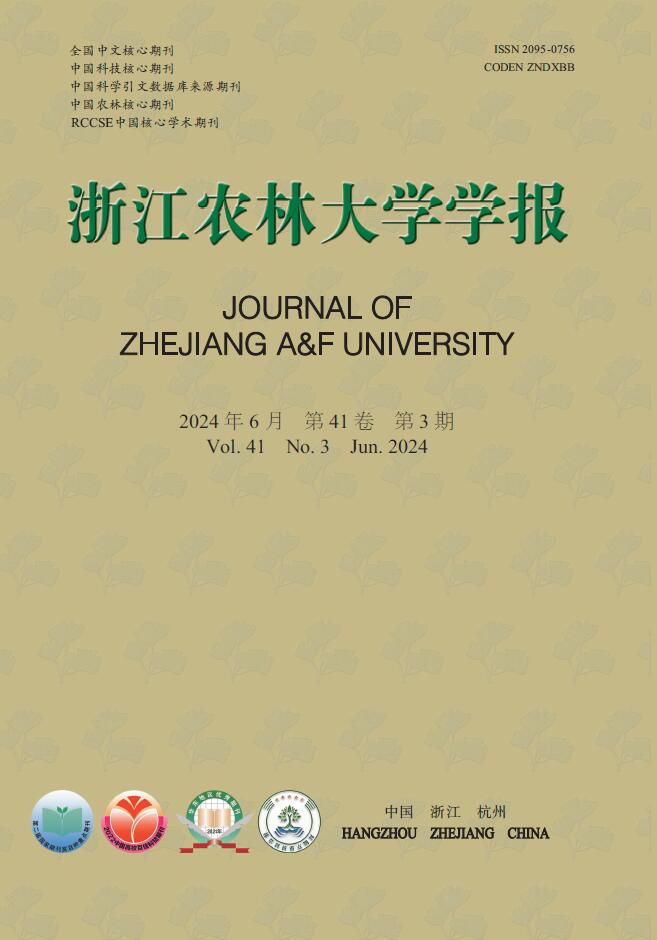


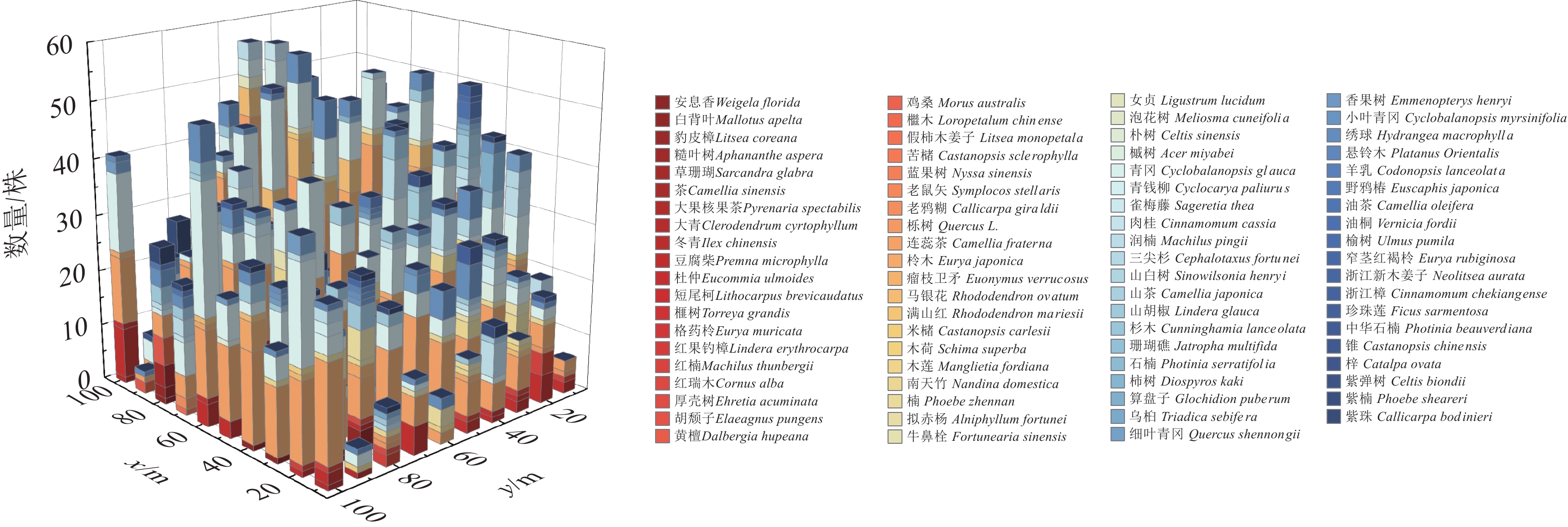


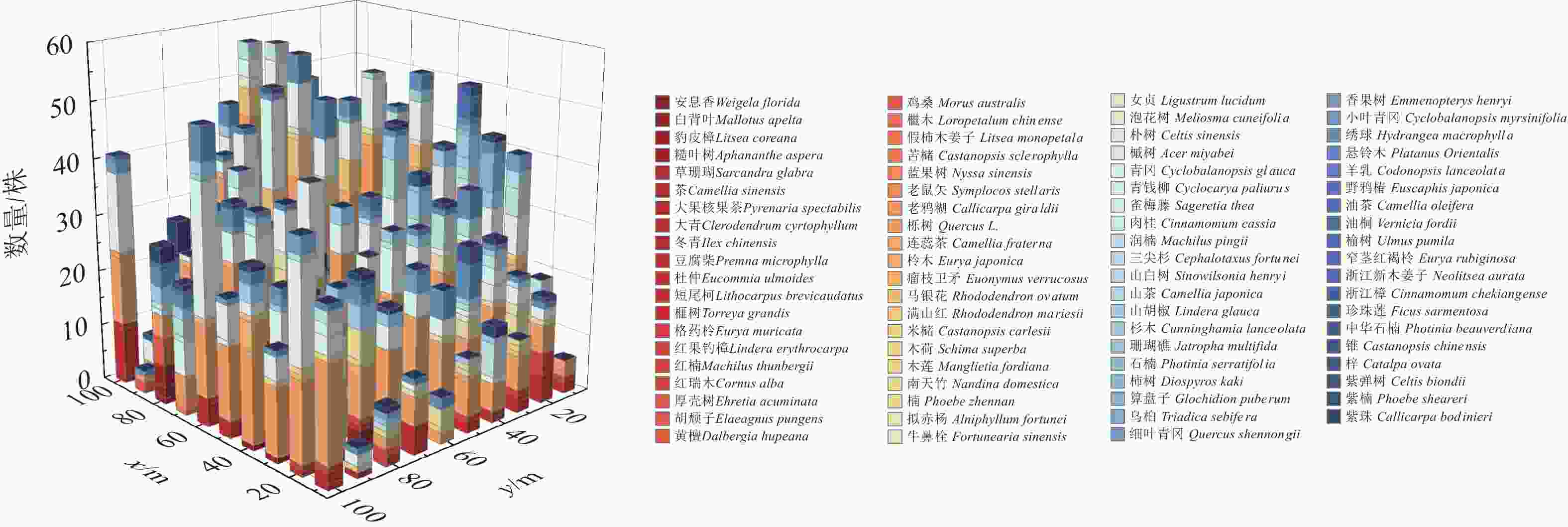
 DownLoad:
DownLoad:
